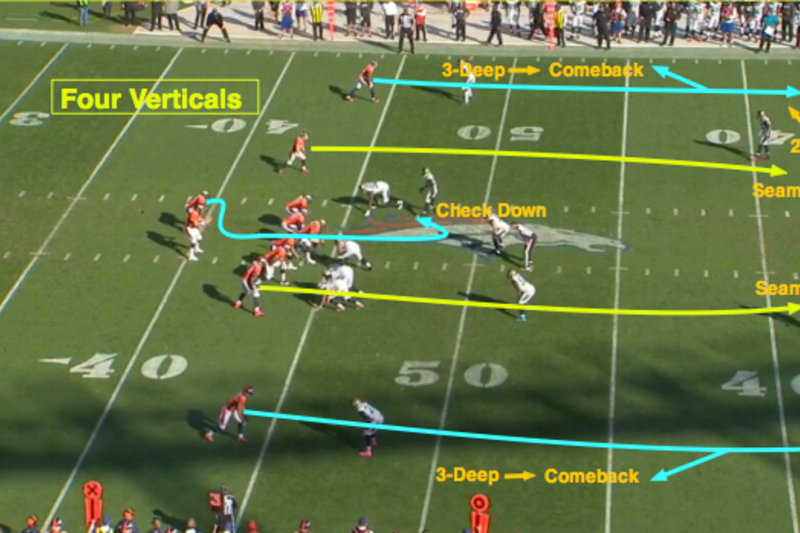A checkdown in football is a short, safe pass. It is usually thrown to a running back or tight end.
Football is a complex game with many strategies. One important concept is the checkdown. This play is a key part of offensive tactics. The quarterback uses it to avoid risky throws. It helps keep the ball moving and avoids turnovers.
Understanding the checkdown can improve your football knowledge. It shows how teams manage the game under pressure. This article will break down the checkdown, explaining its purpose and impact on the game. Whether you’re new to football or a seasoned fan, this guide will help you grasp this essential play.
Introduction To Checkdown
Football is a game of strategy and quick decisions. One critical part of this strategy is the checkdown. Understanding checkdowns can help you appreciate the game better. This section will introduce you to checkdowns.
Definition Of Checkdown
A checkdown is a short, quick pass from the quarterback. It happens when the primary options are not available. The quarterback throws to a nearby player, often a running back or tight end. This play is meant to gain some yards and avoid a sack.
Importance In Football
Checkdowns are important for several reasons:
- They prevent negative plays like sacks or interceptions.
- They keep the offense moving forward, even if just a few yards.
- They can be a safe option under pressure.
Consider this table that summarizes the key points:
| Aspect | Benefit |
|---|---|
| Prevents Negative Plays | Avoids sacks and interceptions |
| Keeps Offense Moving | Gains positive yardage |
| Safe Option | Reliable under pressure |
Situations For Using A Checkdown
A checkdown in football is a safety valve for quarterbacks. It’s a short, quick pass to avoid a sack or interception. Knowing when to use a checkdown is crucial for the success of a team. This section explores various situations where a checkdown is the best option.
When To Execute
Quarterbacks should execute a checkdown when all other receivers are covered. This often happens when the defense is playing tight coverage. The primary goal is to avoid a sack, interception, or forced throw.
Pressure from the defense is another key time to use a checkdown. If the quarterback feels the pressure and doesn’t have time to wait for a deep route to develop, a checkdown can be a safer choice.
Third-down situations are also prime opportunities for checkdowns. If it’s third and short, a quick pass to a running back can gain the necessary yardage for a first down.
Common Scenarios
- Blitz Situations: When the defense sends extra players to rush the quarterback, a quick checkdown can exploit the open space.
- Zone Coverage: Defenses often use zone coverage to guard against deep passes. A checkdown can find the soft spots in the zone.
- Long Yardage Plays: On second or third and long, defenses play back to prevent big gains. A checkdown can gain yards and set up a more manageable next down.
- Red Zone Pressure: In the red zone, defenses tighten up. A checkdown to a running back or tight end can be a quick way to gain yards or score.
Understanding these situations helps quarterbacks make smart decisions. A well-timed checkdown can keep the offense moving and avoid costly mistakes.
Benefits Of Checkdown
Understanding the benefits of a checkdown in football can enhance your appreciation of the game. A checkdown is a short pass made by the quarterback to a nearby receiver, usually a running back or tight end. This strategy offers several key advantages for the offense.
Safety Of The Play
Checkdowns are often safer than longer passes. The quarterback releases the ball quickly. This reduces the chance of a sack. Short passes have a lower risk of interception. Defenders have less time to react. The ball reaches the receiver more quickly. A safe play minimizes turnovers.
Maintaining Possession
Checkdowns help maintain possession of the ball. Even if the play gains few yards, it keeps the offense moving. Short completions can turn into first downs. This keeps the drive alive. Maintaining possession wears down the defense. It gives the offense more opportunities to score.
Executing A Successful Checkdown
Executing a successful checkdown in football involves precise coordination between the quarterback and the receiver. The checkdown play can be a game-saver, especially when the primary receivers are well-covered. Understanding each player’s role is crucial to making the most out of this play.
Quarterback’s Role
The quarterback must stay calm under pressure. Their primary responsibility is to scan the field quickly. If the main options are covered, they must decide to use the checkdown. This process involves reading the defense and making a quick decision.
Once the decision is made, the quarterback needs to deliver an accurate pass to the receiver. Timing is key. The pass should be quick and precise to give the receiver a chance to gain yards. The quarterback’s ability to execute a checkdown can keep the offense moving and avoid negative plays.
Receiver’s Role
The receiver in a checkdown play usually stays close to the line of scrimmage. They must be ready to catch the ball at any moment. Their role is to be a reliable option for the quarterback. They should position themselves in a way that makes it easy for the quarterback to find them.
After catching the ball, the receiver needs to turn upfield quickly. Their goal is to gain as many yards as possible. Good field awareness and agility are essential. A successful checkdown relies on the receiver’s ability to make quick moves and evade tackles.
Training For Checkdown
Training for checkdowns in football is essential for quarterbacks. It helps them make quick decisions and find the best option under pressure. Proper training can improve their skills and game performance. Let’s explore some effective methods to train for checkdowns.
Drills And Exercises
Drills and exercises play a crucial role in training for checkdowns. Start with simple passing drills. Focus on accuracy and speed. Use targets to simulate receivers. Gradually increase the difficulty level. Introduce moving targets and defenders. This helps quarterbacks practice quick decision-making.
Another useful drill is the progression drill. It teaches quarterbacks to go through their reads. The coach sets up multiple receivers. The quarterback must find the open one. This drill helps in recognizing defensive coverages. It also improves decision-making speed.
Practicing Under Pressure
Practicing under pressure is vital for effective checkdowns. Simulate game-like situations during practice. Use a timer to create urgency. This forces the quarterback to make quick decisions. It also builds confidence in high-pressure scenarios.
Incorporate defensive players in practice. They should simulate blitzes and coverage changes. This creates a challenging environment. The quarterback learns to adapt and find the checkdown option. Practicing under pressure prepares them for real-game situations.

Credit: footballadvantage.com
Common Mistakes
Checkdowns are a vital part of football strategy. Yet, many players make common mistakes. These errors can cost games and frustrate coaches. Let’s explore some frequent issues.
Overusing Checkdowns
Some quarterbacks rely too much on checkdowns. This leads to predictable plays. Defenses can easily anticipate these short passes.
Here are some signs of overusing checkdowns:
- Frequent short gains with little yardage
- Receivers left open downfield
- Frustrated teammates looking for bigger plays
Overusing checkdowns can hinder offensive momentum. It’s crucial to balance short passes with deeper throws.
Ignoring Downfield Options
Another common mistake is ignoring downfield options. Quarterbacks often miss open receivers. They focus too much on the short pass.
Why this happens:
- Pressure from the defense
- Lack of confidence in deep throws
- Fear of interceptions
Ignoring downfield options limits scoring opportunities. It makes the offense one-dimensional. This can make it easier for defenses to stop the team.
Quarterbacks need to scan the field better. They should trust their receivers and take calculated risks.
Notable Examples
A checkdown in football is a short, safe pass made by the quarterback. These plays often serve as a last resort when primary options are unavailable. Let’s explore some notable examples of checkdowns that highlight their importance in the game.
Famous Checkdowns In Nfl
Several checkdowns have defined critical moments in NFL history. These plays demonstrate the importance of quick decision-making.
- Super Bowl LI: Tom Brady to James White. Brady’s quick pass to White turned into a 5-yard touchdown. This play was vital in the Patriots’ comeback victory.
- 2010 AFC Championship: Ben Roethlisberger to Rashard Mendenhall. Facing heavy pressure, Roethlisberger’s checkdown allowed Mendenhall to gain crucial yards. This play helped secure the Steelers’ win.
- 2015 Regular Season: Aaron Rodgers to James Starks. Rodgers’ checkdown led to a 65-yard touchdown. This play showcased how a simple pass could lead to significant gains.
Lessons From Successful Plays
Successful checkdowns offer valuable lessons for quarterbacks and teams. Here are some key takeaways:
| Lesson | Example |
|---|---|
| Quick Decision-Making | Brady’s pass to White demonstrated the need for rapid choices under pressure. |
| Awareness of Surroundings | Roethlisberger’s play highlighted the importance of knowing where your teammates are. |
| Maximizing Opportunities | Rodgers’ checkdown to Starks showed that even short passes could lead to big plays. |
By studying these examples, players can learn to execute effective checkdowns. This skill can turn a potential loss into a successful play.

Credit: bleacherreport.com

Credit: bleacherreport.com
Frequently Asked Questions
What Is A Checkdown In Football?
A checkdown in football is a short, safe pass to an outlet receiver. It’s used when primary targets are covered.
Why Do Quarterbacks Use Checkdowns?
Quarterbacks use checkdowns to avoid turnovers and gain positive yardage. It helps maintain possession and control the game.
When Should A Quarterback Check Down?
A quarterback should check down when primary receivers are covered. It’s also used under heavy defensive pressure.
How Does A Checkdown Pass Work?
A checkdown pass involves quickly throwing to a nearby receiver. This receiver is often a running back or tight end.
Conclusion
A checkdown in football can change the game flow. It offers safe, quick options. Quarterbacks use it to avoid risky throws. This helps the team move forward. Understanding checkdowns can improve your football knowledge. It makes the game more enjoyable to watch.
Next time you see a game, look for checkdowns. Notice how they impact plays. Stay curious and keep learning about football.





